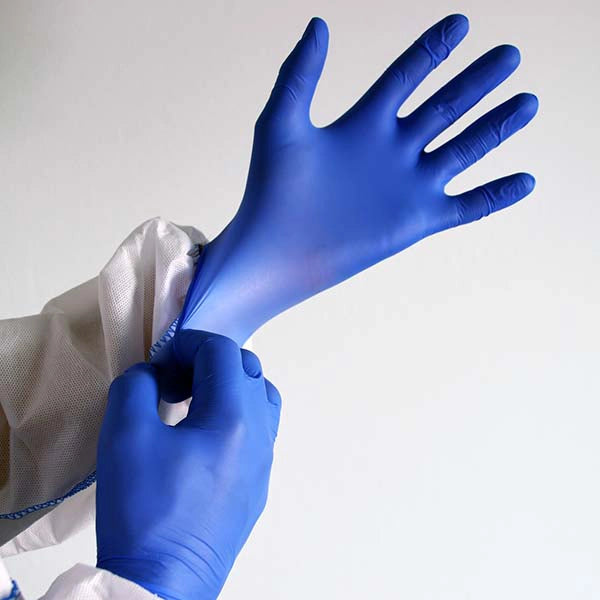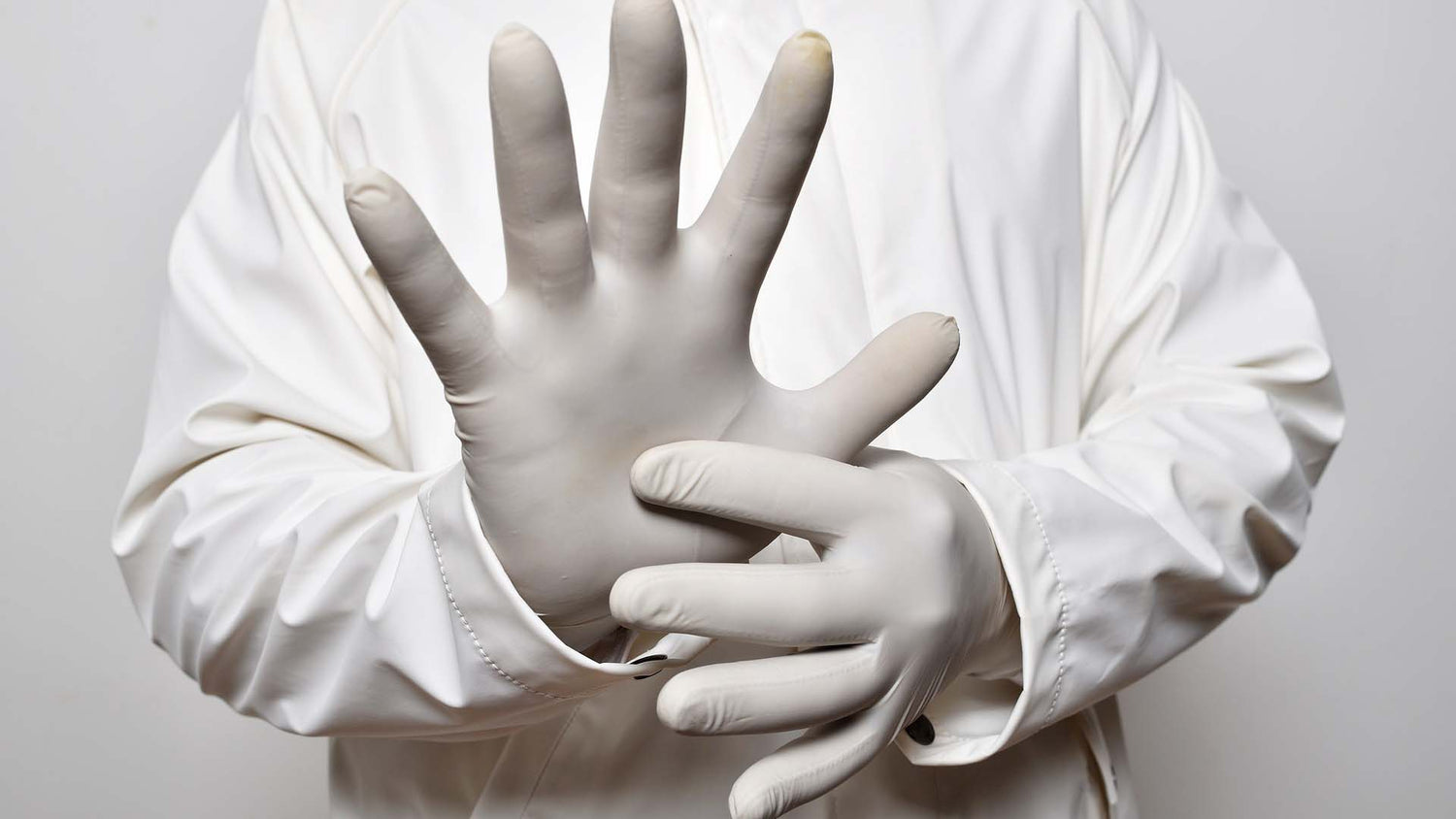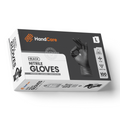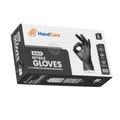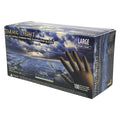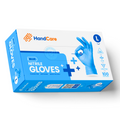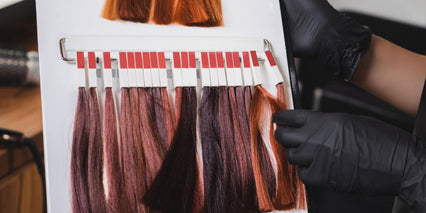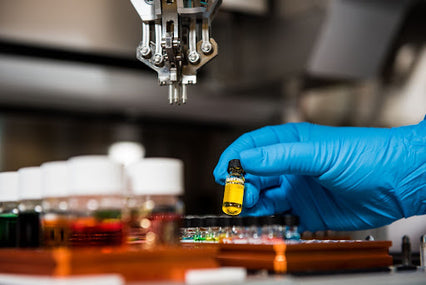When you need a glove to get the job done, how do you choose?
It’s easy to think that disposable gloves don’t require much thought. After all, you’ll pull them on for a quick task and then take them off. In theory, any glove could do the job. In practice, though, various qualities of the glove will dramatically impact how it handles various tasks.
For more and more industries that require durable, flexible, single-use hand protection, disposable nitrile gloves are the leading choice. But the choice of material isn't the only quality that matters. The thickness of the gloves you're using can also be a major factor in how well they perform.
So how thick should nitrile gloves be? Here's how to choose the right glove thickness for nitrile gloves.
At a glance:
Nitrile Glove Thickness Chart
This chart gives you a basic overview of the various nitrile gloves thicknesses, the benefits of each, and how they’re used. For more information, check out the next section on nitrile gloves for various industries.
| Thickness | Benefits | Used For | |
|---|---|---|---|
| 2 to 3 Mils | Thin | Cheap, Good tactility | Food service, beauticians, janitorial |
| 4 to 5 Mils | Medium | Good balance of feel and toughness | Medical, law enforcement, first responders |
| 6 to 8 Mils | Thick | Extra chemical and puncture resistance | Tattoo artists, lab workers, pest control |
| 9 to 10 Mils | Very Thick | Max chemical and puncture resistance | Contractors, hazardous cleanup |
Nitrile Glove Thickness for Various Industries
How thick should nitrile gloves be? The answer likely depends on your industry. The right balance of tensile strength versus tactile sensitivity is impossible to determine without knowing the work you do.
Here are a few examples of jobs well-suited to different nitrile glove thickness levels:
2 Mil to 3 Mil Nitrile Gloves
- Beauticians
- Hairstylists
- Nail salon workers
- Massage therapists
- Janitorial and custodial workers
- Food prep and food service workers
- Housekeeping and hospitality professionals
These thinner nitrile products are affordable yet durable choices for those like food service workers. If you just need a basic barrier and a glove you can shed quickly, these will help you avoid mess or cross-contamination.
4 Mil to 5 Mil Nitrile Gloves
- Doctors
- Nurses
- Dentists
- Emergency first responders
- Law enforcement officers
This nitrile glove thickness range is thick enough to withstand punctures but still thin enough to retain tactile sensitivity. Gloves in this category are appropriate for jobs where you need to worry about exposure to bodily fluids or other infectious materials. If you're working in a healthcare setting, make sure to look for medical grade gloves.
6 Mil to 8 Mil Nitrile Gloves
- Tattoo artists
- Lab workers
- Auto mechanics
- Package handlers
- Pest control specialists
Thicker gloves like 6 mil to 8 mil provide some extra puncture and chemical resistance for jobs involving sharp edges, harsh abrasion, and caustic materials. These are often considered industrial grade disposable gloves.
9 Mil to 10 Mil Nitrile Gloves
- Factory and industrial workers
- Healthcare professionals performing high-risk tasks like chemotherapy
- Environmental hazard cleanup crews
- Electricians
- Contractors
For industrial workers, the biggest priority is puncture protection, so they’ll reach for the thickest nitrile gloves they can. These 9 mil to 10 mil heavy duty gloves may also be a good idea for those working with extremely dangerous chemicals.
Keep in mind that the recommendations above are only general guidelines. The specific needs of your job might dictate a need for thicker gloves than standard in your field. If you have questions about your specific industry, reach out to your nitrile gloves supplier, who should be able to find the perfect glove for your situation.
How Thick Are Industrial Grade Nitrile Gloves?
It's a common misconception that the glove's material or thickness determines whether it counts as a medical or industrial grade glove. In reality, a glove's grade has much more to do with the level of quality control backing it.
Industrial grade gloves generally have to meet an acceptable quality level (AQL) of 3.0 to 4.0, meaning less than 3-4% of a batch can have manufacturing defects. The FDA mandates an even stricter standard of 2.5 for medical grade gloves.
This doesn't necessarily mean that industrial grade gloves are lower quality or less protective than medical gloves. In fact, they're often quite a bit thicker and tougher, because the need for resistance to tears, abrasions, and punctures is greater when you're working with machinery.
However, it's considered less critical if industrial nitrile gloves contain small pinholes or other defects. Those tiny openings matter more for hospital gloves, where there's considerable danger of infections being transmitted through microscopic amounts of bodily fluids.
What Are the Thickest Nitrile Gloves?
10 mil nitrile gloves are considered the thickest standard nitrile glove you can normally buy. You can purchase thicker nitrile gloves of 11 mil and above, but they are expensive, don't offer good tactile feel, and are hard to take on and off.
Why Glove Thickness Matters
The thickness of any type of disposable glove can have a considerable impact on the kinds of jobs it can handle. It’s especially important with nitrile gloves, which are renowned for their durability but often used in jobs where flexibility matters almost as much. So how can you tell when you need a thin vs. thick nitrile glove?
Thin Nitrile Gloves
A thin glove is more economical and cost-effective since it requires less material to produce. It also provides greater tactile sensitivity, which is important for tasks that require great precision. The thickest nitrile gloves may not be the best choice for doctors or nurses, who need to be able to feel for subtle swellings or texture differences during patient exams.
Thinner gloves also feel lighter on the hands, which is pleasant for people who stay in their gloves for a while, have sweaty hands, or only need a basic protective layer (depending on how the glove fits).
Thick Nitrile Gloves
A thick glove uses more material, increasing the cost, but also making the glove much stronger. These are the gloves that can protect your hands without ripping or tearing while you're performing rough work. In the case of nitrile, thicker gloves are also more puncture and chemical resistant.
This makes thick gloves a great choice for those with jobs that call for a great deal of puncture resistance (like medical professionals or industrial workers), chemical resistance (like lab workers or cleaning staff), or both. That’s because there’s more material that has to be torn through. Having more material in the way also gives nitrile disposable gloves a longer breakthrough time (i.e. the time required for a chemical to seep through it).
👉 Shop Medical Nitrile Gloves and save up to 50% today
The flip side is that a thick nitrile glove is somewhat less flexible, which is something to keep in mind for quick, precise tasks requiring tactile sensitivity. Thicker gloves are also a bit harder to remove, which can be an issue for those who need to take them on and off quite easily (like food prep workers or doctors doing basic exams).
Nitrile Glove Thickness Options and Measurement
Nitrile glove thickness is generally measured in mils, where 1 mil = 0.001” gauge. A glove of 3 mil and below is considered thin. Gloves at 4 mils (like our HandCare blue nitrile gloves) or 6 mils (like our Advance Plus orange nitrile gloves) are considered medium thickness for nitrile gloves, ideal for those who need a balance of protection and dexterity.
A thicker nitrile glove, measuring 7 mils or more, would be unusually rugged for household use but could be well-suited to heavy-duty manual labor. (Our Dark Light black nitrile gloves are good examples.)
Nitrile Glove Thickness by Area
However, keep in mind that the thickness of a nitrile glove isn’t uniform. In fact, thickness changes depending on what part of the hand you measure.
Nitrile gloves are generally made by dipping a hand-shaped mold in a vat of liquid synthetic rubber and letting it dry upside down. Since the fingertips are the lowest point, a little bit more of the material tends to pool there, making them the thickest parts of the glove. The wrists, in contrast, are usually the thinnest part of the glove.
Any measurement of glove thickness is usually based on the thickness of the fingers. This makes sense, because your fingers will often have the most contact with various surfaces and are thus most susceptible to punctures and tears.
The fingertips are also usually the most important area for feeling the consistency, texture, and shape of whatever you're handling. That's one reason that thinner gloves provide greater tactile sensitivity.
Shop Nitrile Gloves On gloves.com
No matter what nitrile gloves you and your team need to get the job done, we offer a great selection that you can count on to tackle your biggest tasks. Our collection of nitrile gloves includes every size from extra-small to XXL - not to mention thickness options from 2 mils to more than 10 mils.
Check out our nitrile gloves product page and find the hand protection your job demands.
We also offer bulk nitrile gloves for larger orders. Save up to 50% today!

